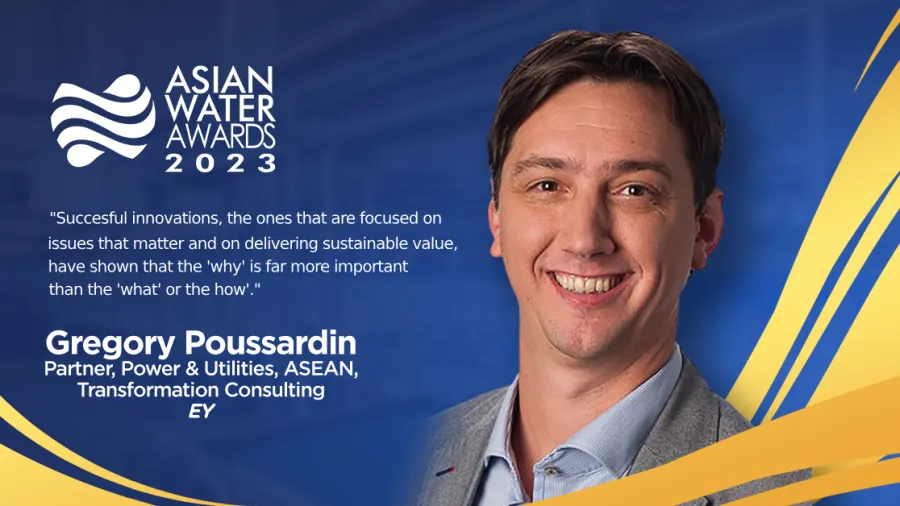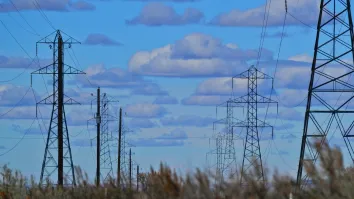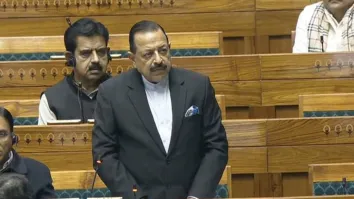
EY’s Gregory Poussardin: Value, balance and focus must be at the core of the energy transition
Gregory identified region-specific opportunities to enhance water management and sustainability practices, as he advocates for the adoption of intelligent water capabilities integrated with customer-centricity practices.
The water sector faces unprecedented challenges in the wake of climate change, population growth, ageing infrastructures and increasing freshwater consumption. As water scarcity becomes a pressing concern, innovations and sustainability efforts in this sector are paramount.
Gregory Poussardin is a Partner at EY Consulting. Based in Kuala Lumpur, he has 20 years of experience in advisory services for leading Power & Utility corporations across the water, wastewater, electricity, and gas domains. As a judge at the Asian Water Awards, he brings his wealth of experience and insights to assess projects that are making strides towards water management and sustainability.
Gregory emphasises the pivotal role of digital technologies in driving transformative and sustainable change. He highlights the integration of Artificial Intelligence (AI), Advanced Analytics (AA), and Machine-to-Machine (M2M) technologies in network management systems, coupled with Internet of Water (IoW) initiatives, as a fascinating development for the water sector. These technologies enable water utilities to analyse vast amounts of real-time data from diverse sources, aiding in vulnerability detection, non-revenue water reduction, supply-demand forecast, and operations improvements that can generate positive impacts on energy consumption, carbon emissions and eco-invested customers. Gregory sees this integration as a game-changing catalyst in the sector, enhancing both operational efficiency, customer outcomes and environmental sustainability.
In your experience, what are some of the most significant trends and innovations you have observed in the power and utilities sector, particularly in the context of water?
The P&U sector is undoubtedly one of the most exciting and disruptive (-ed) industries to work with. Whilst a few outsiders may still spread the outdated orthodoxy that utilities remain traditional players, I have been fortunate enough to witness their progressive transformation over the last two decades, collaborating across five continents with nascent organisations and recognised leaders, segment-specialised and vertically-integrated utilities, private and publicly-owned, operating within highly-regulated regimes or liberalised markets. They all share one constant: innovation at the heart.
Nowadays, the structural changes triggered by the energy transition combined with the net-zero imperative and geopolitical uncertainty are creating the perfect storm for accelerating innovation and business-to-technology transformation in the sector. Utility companies keep reinventing themselves as they face an unprecedented set of multiverse forces. Together, these 5D forces — Decarbonisation, Decentralisation, Digitalisation, Deregulation, and Democratisation — are giving birth to a new integrated energy ecosystem that is interconnected, multi-directional, omnisumer-driven, and digitally enabled. A catalyst for a new wave of innovations at pace and scale in the sector, with purpose. Water is no exception. Earth is after freshwater, with growing scarcity challenges. Essential services by definition, the water sector has a long pedigree for innovation. I have always been thrilled by the reverse osmosis technologies — one of the top scientific achievements in human history, dating from the 18th century – now turning oceans to meet our growing needs where circa 23,000 desalination plants provide drinking water to 300 million human beings in regions with high water stress, according to the International Desalination Association.
From a digital standpoint, the integration of Artificial Intelligence (AI), Advanced Analytics (AA) and Machine-to-Machine (M2M) in network management systems, combined with the Internet of Water (IoW) is one of the most fascinating recent developments. With their ability to analyse large amounts of data in near-real time from multiple sources, AI-related technologies can help water utilities detect potential network vulnerabilities, reduce non-revenue water, predict supply/demand variations, minimise the risks of disruption to the consumer, improve network performance, and lead to operational optimisation with a direct impact of the environment and customer experience. A game changer.
As the industry moves towards sustainability and Net-Zero goals, what are the key challenges that utilities face in balancing environmental impact, customer demands, and financial viability?
Sustainability is everyone’s business. With climate change as the ultimate mega trend, energy transition as a top global priority, and the P&U sector as one of the largest sources of greenhouse gas emissions, the industry is under the spotlight.
Answering this question means answering the hot spot that most utilities worldwide are looking to solve: How to go green without going red?
In other words, how to: balance the bottom line with the green line; provide reliable, affordable, sustainable power or water services; meet eco-friendly customers’ expectations who are now leading the way, and marry short-term commercial objectives with the necessity to evolve their business and operating models?
Due to the growing number of intricate challenges, utilities are walking on a tightrope, making the energy trilemma even more difficult to balance. The sector is facing multi-pronged challenges, sometimes with competing objectives: rise of decentralised renewable energy; adoption of cleaner energy sources and technologies; growing pressure from regulators, stakeholders, investors, and consumers to demonstrate sustainability value; ever-expanding electrification requiring significant infrastructure investments; necessary operational cost reductions; disruptions from new entrants and business models - all whilst dealing with growing energy system complexity. As the market evolves towards a new era - arguably the most complex of all, where the industry is expected to be changed forever - many utility leaders do feel a sense of urgency. These leaders are overwhelmed by the diversity and pace of the challenges.
To succeed in the energy transition, utilities must determine what is the most suitable path for them by leveraging their market position and strengths. Value, balance and focus must be at their core. The three largest European utilities in terms of market capitalisation offer perfect examples of successful balanced decisions between driving the ESG agenda, meeting customer expectations, and securing significant investments to deliver sustainable growth.
In Ancient Chinese philosophy, opportunities often arise from crisis (危机). Utilities do not only face complex challenges. They also contemplate an unprecedented wave of opportunities to reinvent themselves and create the business of the future.
With your current focus on supporting Malaysian and ASEAN utilities, what are some of the region-specific opportunities you see enhancing water management and sustainability practices?
In ASEAN, high non-revenue water (NRW) rates, ageing infrastructures and subsequent operations costs have been curtailing the water industry’s ability to provide water reliably, economically, and sustainably. In Malaysia for instance, the National Water Services Commission (SPAN) has reported 2022 a national average NRW of 37.2%, resulting in a waste of 7.084 million litres of treated water daily with a total loss of around RM2b a year (circa USD$430m). Physical losses in pipework make up 80% of NRW where almost a third of the water pipes‘ length is made of asbestos cement, which tends to burst easily. The opportunity to run water education and reduction programs is getting on top of the country's agenda.
Local and regional water utilities contemplate a land of opportunities with the ability to benefit from leading practices in integrated water management, conservation management, digital technologies, and sustainability. In our region, the starting point must be operational, tangible, and executed from the ground. For instance, integrated enterprise asset management practices spanning across the asset lifecycle together with the development of intelligent water networks as the infrastructures evolve should be key benefit areas for ASEAN water companies. It is all the more a strategic opportunity in the context of a fragmented market structure where extending asset life and obtaining access to capital for infrastructure funding remains a challenge with limited private and international investments.
Intelligent water networks are at a nascent stage of development in the region. Their progressive implementation will offer a range of capabilities to tackle high non-revenue water, promote better water conservation initiatives, provide better operational data insights, drive operational efficiencies to reduce the net total revenue loss and unlock new offerings to increasingly ESG-conscious customers. To fully achieve the expected benefits, public infrastructure restructuring programmes to centralise the management of water supply and sanitation may also be required, like the Three Waters reform in New Zealand.
Positioned at the heart of the business strategy, these capabilities, combined with ESG and customer centricity can help to deliver sustainability-led value where the hidden planning, asset and field operations are constantly integrated with customer capabilities across the traditional silos to deliver the ultimate service experience with purpose.
This is a new battleground. Some of our regional water utilities are already paving the way. Exciting time ahead for the region!
How do you see the role of digital technologies in transforming the water sector? Can you share some examples of how digital-enabled transformation has made a significant impact in this industry?
For decades, water utilities have been focused on servicing assets. They have been operating through traditional structures that promote operational and functional expertise. Customer interactions have been driven by vertical silos of corporate and operational specialists, resulting in friction since vertical types of organisations are not designed to meet evolving eco-invested and tech-savvy customers’ expectations.
Both digital technologies and data capabilities have lagged in the sector, whereas they are one of the key enablers in executing the required transformation where water utilities expect to drive towards more dynamic, connected, proactive, automated, and innovative capabilities by leveraging digital sensors, IT/OT integration, AI, and machine learning. These technologies have direct applications in four major clusters: Connected Workers, Smart Assets, Dynamic Operations, and Empowered Customers.
Some water utilities in geographies like Europe and Oceania have been moving quickly to leverage these technologies to propel them towards a new future. These companies have started to leverage some digital pockets of good, before extensively investing in digital overhaul programmes. The most successful ones use digital as a vehicle for transformation. They are reinventing themselves by embracing digital DNA to evolve towards the holy grail in the water sector: the “hyperconnected water utility.”
The hyperconnected water utility can be defined as an organically integrated ecosystem from operations to customers, from OT to IT technologies, and from back office to front office. It leverages the information and insights from multi-dimensional data collected, ingested, analysed, and visualised with multilayer digital platforms. In summary, hyperconnected water utilities operate a dramatic change by shifting from operations to customer-centricity and focusing on proposing differentiated and end-to-end experiences to each community segment. The water sector offers us several iconic case studies of such digital-enabled transformations. Let me share some of these stunning value initiatives that are changing the face of the industry.
Several water companies across Europe, Oceania and Asia have embarked on ambitious Artificial Intelligence and analytics modelling projects that connect the early stages of the water value chain to end consumption – “dam to tap” – to improve water supply and demand optimisation.
Other water utilities in the UK have been exploring the opportunity to disrupt the O&M supply chain by equipping their technician vans with 3D printers for spare parts.
Urban water retailers across Victoria have designed digital business models leveraging intelligent meter and network capabilities to offer smart and environmentally friendly services to the community.
Finally, the large environmental and water services companies from France are amongst the pioneers who started to unsettle the water industry equilibrium in Europe by providing a range of innovative services in the areas of design and engineering, digital water operations, remote network monitoring, water and energy optimisation, wastewater to energy, circular economy initiatives, etc. They have incubated these new digital capabilities in their very own innovation start-ups and labs.
However, water utilities do not become trailblazers with digital capabilities alone. Technologies are a must-enabler, albeit they are not the key trigger of successful transformation. Despite the progress in delivering digital initiatives, only a few utilities achieve the desired outcomes, and many of them keep struggling to deliver the promises of their transformation efforts according to experts. The secret sauce lies elsewhere, in how water utilities embrace the right model, orchestrate their multi-speed ecosystem, and deliver long-term value to their stakeholders with ESG at the core of their business strategy. This is not a simple equation to solve and a fascinating topic we may debate in another paper.
As a judge at the Asian Water Awards, what are the qualities you look for when evaluating nominees? Could you elaborate on what makes water-related projects stand out?
Water is an essential ingredient to ensure an equitable energy transition and a sustainable future. Freshwater is the highest demand in all natural resources. It is under severe pressure from the current rate of consumption and is one of the scarcest resources in the future according to experts. It is also a key driver of economic growth and social development. In short, water is essential to life. It is a vibrant industry that requires our utmost care for the benefit of our children and future generations.
For all these reasons, I am humbly honoured and truly proud of having been selected as one of the judges for the inaugural Asian Water Awards.
Successful innovations, the ones that are focused on issues that matter and on delivering sustainable value, have shown that the “why” is far more important than the “what” or the “how.” Nominees can expect me to start by assessing purpose and outcomes when considering their projects.
As a second layer, my evaluation will rely on five major dimensions based on the ability to: create a positive replicable impact at scale; address specific water challenges for the region like water leakage, river pollution, water-related diseases, and flood management; leverage existing technologies and assets with new digital capabilities; deliver on the ESG agenda; and showcase a solid business case with articulated qualitative and financial benefits.
What will make a nominee stand out, in my opinion? The human impact.

















 Advertise
Advertise






